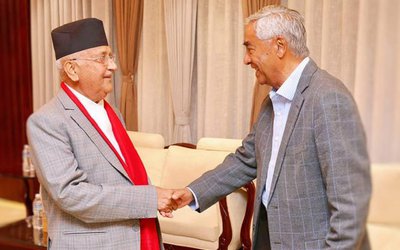(PART -0NE)
A. Introductory Background and the Context
According to the 2021 Corruption Perceptions Index by Transparency International, Nepal is one of the most corrupt in South Asia and it ranks one of the top fifteen most corrupt in Asia. Corruption is a well-documented issue in Nepal, and several government institutions and individuals have been implicated in corrupt practices. According to Transparency International's Corruption Perceptions Index 2021, Nepal is ranked 117th among 180 countries, indicating that corruption is still a significant problem in the country. This has not improved in real terms yet. There have been reports suggesting executive branch of the government, judiciary, public procurement, security agencies, public transport, health care system and education sector have been perceived by people involved in corruption.
Examples of corruption show corruption and political interference in the judicial system involving the appointment of judges and the handling of high-profile cases; the police force's for accepting bribes and engaging in other corrupt practices concerning traffic violations and land disputes; public procurement process for lacking transparency and accountability, and absence of performance auditing and collusion of interests; financial mismanagement in the health sector in the procurement of medical supplies and equipment; education sector concerning the allocation of scholarships and the appointment of teachers; lack of proper accounting of approved budgetary allocations authorized for disbursements during the year-end (Beruzu account) remain unaccounted for years under successive governments.
Sources of the major conflict of interest in Nepal seem to have emerged prominently and openly in the public domain with the promulgation of the state of Nepal into a federal democratic republic and the rise of political oligarchs in the name of an illusionary federal democratic system of governance. Understandably, a certain level of conflict of interest could have been expected because of age-old socio-economic inequalities entrenched in a society with diverse ethnicities, cultures, and conflicting traditions, for these issues are trapped within the confines of inter-generational poverty and feudal mindset, lacks critical thinking, and awareness of functional education and prefer political interferences at all levels of governance while keeping financial interests, impunity, and nepotism unbroken.
This landscape can be fertile ground for the radicalization of the population in a socio-political context. This could further weaken governance modules without realizing such imbalances could generate destructive forces in the nation-building process. This phenomenon easily manipulates the national psyche and has an adverse impact on political, social, and economic development prescripts in a nation's thinking, and impacts fairness and good governance.
Is conflict of interest the mother of corruption?
Conflicts of interest occur when an individual or organization has competing interests that interfere with their ability to act impartially or in the best interest of others. This creates opportunities for corrupt behavior, such as when public officials use their positions for personal gain or when businesses use their influence to secure favorable treatment.
One must equally recognize that conflicts of interest are not always inherently corrupt, and many organizations have policies and procedures in place to manage them appropriately. Additionally, corrupt behavior can occur even in the absence of a conflict of interest, so it is important to address corruption through a range of measures, including transparency, accountability, and effective law enforcement.
B. Issues of Public Concern
Root Causes of common conflict of Interest in Nepal
Some common causes perpetuate competition over actual incompatible desires which have the potential for developing into conflict over varieties of issues, money, resources, time, power, and authority to satisfy own needs at all levels of social and economic spheres, including at work and institutions impacting operating modules resulting into widespread corruption to malfunctioning of democratic norms of governance. Contextual comprehension of such situations requires a deeper understanding and recognition of the socio-economic compact, and political environment construct together with associated evolutionary trends in people's psychic. More importantly, what it meant by conflict of interests in the following areas will require contemplation before enacting preventive measures:
(1) Political power: Different political parties and factions within the government modules would have conflicting interests in terms of gaining and maintaining power. Nepal has had a long history of political instability and conflict, with different political parties and groups competing for power. Political violence, protests, and strikes are common. These are common occurrences from learning institutions to civil organizations, and state enterprises disrupting public services delivery and quality education affecting daily life and business. Checks and balances between the power centers are required in a democracy for the effective functioning of institutions and for ensuring the delivery of services for the greater goods of the public. But in this republic, it has been severely undermined by political parties' obsession with power for personal gain and authority at any cost, like in an autocracy, as evidenced by the current party politics in Nepal.
(2) Ethnic and regional identities: Nepal is a diverse country with ethnic and regional identities, but not a large population like in some other nations like India, Nigeria, or Ethiopia. Conflicts would easily arise when diverse groups feel that their interests are not being adequately represented or protected by the government. Sometimes ethnic groups could have conflicts with each other on issues of little importance at the national level when communities become radicalized for various local reasons. For example, Madhesi people in the southern Tarai region have had conflicts with the Nepali-speaking hill people over issues such as language, representation in government, and resources. Likewise, silent, and unnoticed tension arising from population movement or relocation for economic and social reasons from other regions to urban areas in Tarai, Kathmandu and Pokhara valleys could generate future conflicts. There may also be other issues slowing developing as such when people become increasingly aware of their identities, socio-economic isolation, and demand state recognition.
(3)Religious conflict: Nepal is a predominantly Hindu country, but there are also significant Buddhist and Muslim population and a growing number of Christians. Media reports indicate there have been tensions between Hindus and Buddhists in the past over issues such as religious practices and festivals, and social events linked with class identities and ethnicity.
(4)Resource allocation economic inequality: Conflicts may arise over the distribution of national resources and state revenues including land, water, forests, and minerals in areas with valuable natural resources. According to World Bank data, Nepal has the highest tax rate in terms of GDP per capita in the sub-continent while being one of the poorest countries in Asia. This would imply there would be, in the future, more often conflicts over resources, such as land and water and state subvention to support different tiers of governance structure. This means government policies and development projects could also lead to conflicts of interest with local communities.
(5)Corruption in the governance system: Financial and political corruption are the major obstacles to good governance in Nepal. Conflicts, however, could also emerge, without many realizations of the ground situation, when individuals or groups seek to exploit government resources or influence for personal gain. Government involvement in corruption scandals is plentifully reported by news media. A few examples illuminate the scale of the problem. Scandal on medical supplies procurement deals with OMNI; scandal on collusion between senior officials of Inland Revenue Department and Tax Settlement; controversy surrounding the implementation of the never-ending Melamchi Water Supply Project which overran initial costs at every turn of the execution and has displayed abject mismanagement of large project work; scandal involving land acquisition at Lalita Niwas inside Prime minister of Nepal's residence may adequately highlight the ebb and flow of corruption patterns at different levels of governance. Similarly, anomalies surrounding Nepal Airline Corporation's violation of the Public Procurement Act in purchasing and/or leasing aircraft are widely reported in local media. It shows the government's ineptness in managing state enterprises which only magnifies authorities' zeal for abuse of power and display of the government's extravaganza of financial resources.
(6)Foreign relations and regional conflicts: Nepal's relationship with dominant powerful neighboring countries, like India and China, would remain a source of conflict, particularly in terms of trade and border disputes, despite successive governments repeatedly claiming, now and again, that they are close friends. Political elites use this proclamation, more frequently than ever in China and India, and according to political leadership's interests and choices. Without delving into the realities, context and facts of the issues, the population at large is being polarized against each other in shrouded themes of nationalism and sovereignty without consideration of the larger interests of the common people. This is the utmost conflict of interest that dominates Nepal's socio-political landscape. It has, thus, become a major roadblock in forging collaborative partnerships with the neighbors, and Nepal has miserably failed to become a vital connecting economic and socio-cultural bridge between the two major world powers. This does not require compromises over nationalism or sovereignty, as trumpeted and orchestrated, and promoting Nepal's future development alignment and interests with the systems of those of its neighbors while maintaining strategic autonomy, and ensuring that Nepal could benefit over trade, education, tourism, transport, infrastructure, manufacturing, supply chain, information, technology, water resources, and other mutually beneficial joint efforts, including in climate adaption and mitigation, and avoid border tensions, for example.
(7)Socio-economic issues: With a high level of poverty, low wages and income, out-migration of the productive work force for education, work, and future job opportunities overseas, falling agricultural production of basic food commodities, lack of skills development and productivity, absence of affordable quality healthcare, transport and, sustainable infrastructure development could lead to conflicts of interest within the different tiers of governance, socio-economic strata, and community due to competing interests and priorities over resources and funding.
Continued…
Analysis and opinion expressed in this piece are of Kedar Neupane, who is a founding board member of Nepal Policy Institute which is an independent non-political international think tank, and is a former staff of United Nations High Commissioner for Refugees. Neupanek1950@gmail.com)

Kedar Neupane
He can be reached at Neupanek1950@gmail.com
- Talking About South Asian Diaspora Community And Its Economic Prowess In The USA
- Aug 23, 2023
- Talking About Growth Miracle And Emerging Quadripolar Economic Construct (Part – Two)
- Jul 28, 2023
- Talking About Growth Miracle and Emerging Quadripolar Economic Construct (Part – One)
- Jul 02, 2023
- Pseudo-Nationalism Is About Political Desperation And Sure Sign of Economic Collapse Context And Background
- Jun 19, 2023
- Realities In Conflict Of Interest And Challenges Of Combating Corruption In Nepal: PART -TWO
- Jun 08, 2023














